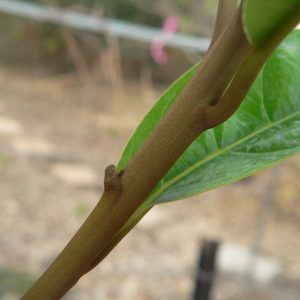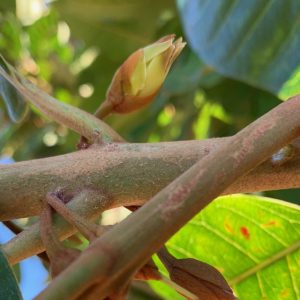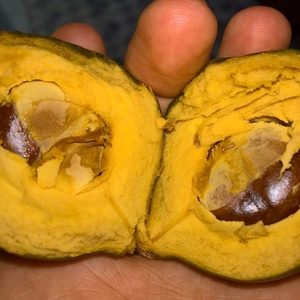Lucuma (Pouteria) arguacoensium (deliciosa)
Manzano, manzana, nawu
Although this species is quite rare in our part of the world, members of the club have been fortunate in obtaining seeds and germinating seedlings. It has received little scientific study of its behaviour and properties apart from what has been reported in taxonomic work, so only limited information can be provided below. Some guidance on management can be inferred from what has been established with better known relatives. Morphological and genetic evidence indicates that Pouteria multiflora (Camitillo) and P campechiana (canistel) are closely related, and information on these is included in this Section.
Origin
The native range is Colombia.
Climate
It is found in wet montane forest between 1000 and 2300m asl at latitudes around 10° North. Average rainfall in these regions at elevations of 500-1,500m is 4000mm/pa, and temperature varies between 0 and 26°C.
Plant Description
Trees grow to 15m in Colombia, most likely less in our climate and soils. Shoots are pubescent with fine golden hairs when young, and with maturity they become glabrous. Elliptic-obolanceolate spiral leaves, 12-25cm X 5-8cm on 1.5 – 2.5cm petioles, are glabrous on the upper side with golden-brown hairs on the lower, and usually have an acute apex and base. The mid-rib on the adaxial side is not raised and there are 12-14 pairs of secondary veins.
Relatives
It belongs in the Sapotaceae family and the genus Pouteria contains about 250 species, many of which originated in the neotropics. There are many fruiting relatives, including mamey and green sapote, canistel, lucuma, abiu, star apple and sapodilla.
Soils
The soils in native areas are slightly alkaline, a positive tolerance feature for growers in Perth coastal areas having to deal with calcareous and alkaline conditions.
Propagation
As a species without any development work it’s likely that almost all trees are grown from seed.
Cultivars
Unknown
Flowering and Pollination
Inflorescences are axillary or ramiflorous fascicles clustered towards branch endings. The usually single tetramerous greenish-white flowers are hermaphrodite with golden-brown sepals on the outside, a cylindrical corolla tube 6- 10mm long with 6-7 lobes 3-4mm long, stamens (6-7, 2mm long) and staminodes (6-7, 3-4mm long) inserted at the top of the tube, a 6-7 locular ovoid ovary, and a pubescent commonly exserted style 9mm long at anthesis. There is no nectary disk.
In Colombia flowering occurs throughout the year.
Cultivation
Manzano is an understory tree in native montane rainforests, so should be capable of growing in partial shade here. Constant shedding of litter material (several tonnes/ha/yr of leaves alone) and rapid breakdown in the humid wet climate would ensure continual organic nutrient supplies, suggesting mulching around our plants will help.
Wind Tolerance
Unknown
Pruning
A wise strategy would be to train the plant in a vase-shape to maximise sunlight penetration, improve aeration to minimise fungal diseases, and to keep size manageable for easy harvest. Apical dominance needs to be managed.
The Fruit
Fruit with a greyish-green skin and yellow (sometimes pinkish) semi-dry sweet flesh are ovoid to sub-globose berries, 8-12cm long. They contain 2-3 shiny smooth black seeds with a pale adaxial scar that can cover much of the seed and is attached to the pulp. The taste has been likened to that of mangosteen in an old reference.
Fruit Production and Harvesting
Harvest is mainly in spring.
Fruit Uses
Colombians mainly eat the fruit fresh, but they could also be used with other fruit to make smoothies, or to flavour cakes and ice-cream.
Pests and Diseases
Unknown, but fungal problems may be minimal in our dry climate given it has evolved in a fertile high humidity region.
Comments
It’s hoped this species will grow in Perth’s sub-tropical climate given it’s native in Colombia at middle altitudes (1300-2300m). It’s bisexual so a single plant will likely be sufficient for fruiting, and naturally it is not a big tree so should be possible to accommodate on less than acreage property. The species grows naturally in rain forest areas with heavy precipitation, so in our dry climate sufficient watering would need to be ensured.


